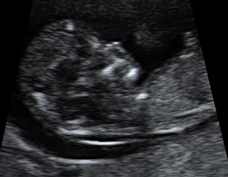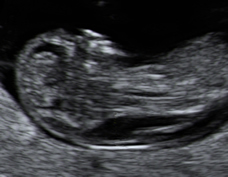Nuchal Translucency Screening

An ultrasound scan, known as the nuchal translucency screening, is done between 11 and 14 weeks of pregnancy and is used to help assess your baby's risk of Down syndrome. During this test, the sonographer measures the depth of fluid under the skin at the back of the baby's neck, known as the nuchal fold. If this measurement is high, it indicates that excess fluid is present, which means that the baby has a higher risk of Down syndrome. The measurement is then combined with the results of blood tests and the average risk based on your age to give your baby's individual risk for Down syndrome. If your risk is higher than 1 in 250, you will be counseled and offered a diagnostic test, such as amniocentesis or chorionic villus sampling, to give a definitive result (see Chorionic villus sampling).

The small depth of fluid seen in the neck's nuchal fold in this scan means that the fetus has a low risk of developing Down syndrome.

The thicker nuchal fold seen here indicates an increased risk of Down syndrome in this fetus and a diagnostic test will be recommended.